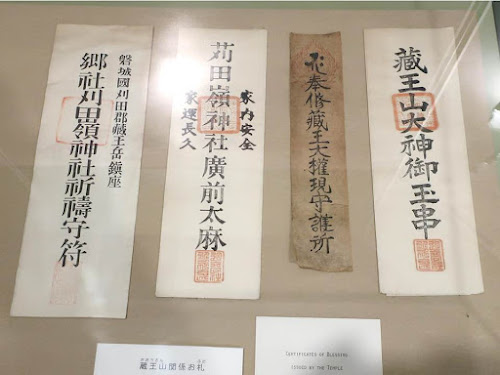This
museum is in the Kaminoyama castle which was rebuilt in 1982. Kaminoyama city has
flourished as a post town of both of Ushu kaidou and Yonezawa kaidou
highway. It is located around 300km north of Tokyo. We can see Kaminoyama city
and Mt. Zaou (1841m height) from the top of the castle. I saw people having fun at the hot spring (Onsen) resort, and also while climbing
mountains. (Taking pictures and uploading to
the website was approved when I visited.)
 |
| Kaminoyama castle |
 |
| View from the top of the castle |
1982年に再建された上山城の中にある資料館。上山市は山形県南部の羽州街道と米沢街道の宿駅として栄え、蔵王への登山基地と温泉地として有名。最上階からは市街と蔵王を見渡せる。温泉町の賑わい、蔵王への登山、出羽三山への登山の人々の楽しみを見た。(撮影及びブログ掲載許可取得済)
Three mountains (Mt.Haguro, Mt.Gassan and Mt.Yudono) in Dewa region
are famous for holy places of Japanese mountain asceticism. The number of
pilgrims called “Gyoujya” reached its peak period in the Edo period, so
the post towns on the kaidou highway including Kaminoyama flourished very much.
出羽三山(羽黒山・月山・湯殿山)は修験の聖地として栄えていた。江戸時代には最盛期をむかえ、上山を含め街道沿いの宿場は行者で賑わった。
 |
| Kanenowaraji、金草鞋 |
The
book above is a guide book of Dewa Mountains which was written by the famous
author Jyuppensyaikku (十返舎一九). I am surprised that ordinary people could read this book. Sad to say, I cannot read these characters and sentences. They could enjoy virtual travels by books.
Btw, according to the explanation, it is written “Guys in Kaminoyama can lift up a rice bag easily,
although they cannot resist ladies” on this page. This book introduces shrines in Dewa Three Mountains and post towns on the Yonezawa and Rokujyuurigoe kaidou
highways. It is also written with funny sentences and poems.
Kaminoyama local government levied 20cent on
passengers. It was recorded 10,000 people went to Dewa mountains in summer at
the same time. The earned money was donated to the temple which controlled pilgrims, and the money was spent in
the festival in which dried squids were delivered. Kaminoyama is in a
mountainous area, so I think people delighted to be able to eat seafood. It
would be a good idea.
金草鞋は十返舎一九作、歌川国安画の出羽三山詣での案内書。文字がたっぷり書かれているが、江戸後期の人はこの字を読めたのか。レベルが高い。読む旅を楽しめる。上山宿を紹介したこのページでは、俵を持ち上げる男の横に、「女には弱いが力はこの通り強い」と書かれているらしい。この本では、出羽三山各社、米沢・六十里越の街道の各宿について、滑稽な文章に狂歌を交えて書かれているという。さすが、東海道中膝栗毛の作者だ。
上山を通る羽州街道は、関東から出羽に向かう参詣路の一つで上山藩では通行者から五文を徴収していた。夏が参詣者のピークになるが、一万人が通過していたことが残されている。大部分は修験者を管理する清光院に渡されるが、「お柴焼」の費用にも使われている。隣接する南陽市に一年の無病息災を願う「御柴灯焼き」という1月15日に行われる行事があり、するめをもらえるらしい。このような振る舞い費用に使われるのだろうか。良い配慮である。
Pilgrims
got talismans at visited shrines as souvenirs, which would be appreciated by
villagers of their hometowns. The picture of a bull is powerful.
火除けの牛札(羽黒山・正善院)、厩安全のお守り(羽黒山・正善院)、出世長寿の大黒天(湯殿山・注連寺)
訪ねた山ではお札をいただく。多分、近所にも配り喜ばれたのだろう。牛札は迫力がある。
Pilgrims
climbed Mt.Zaou since 679. The routes were fixed in 1219 after the eruption in 1182. Commissioners were designated for each route to maintain the mountain roads. The commissioner would have
been a mountain guide for pilgrims.
蔵王は、679年に役小角が吉野山から蔵王権現を勧請して開山した。1182年に蔵王山が噴火したが一年後には再建。早い。噴火は1600年代にも起こる。1219年に登拝路が定まり、それぞれの道に別当が置かれる。上山口の別当は安楽院となり、中腹に小屋を建てるなど参拝人を先達するための整備を行う。これは山岳ガイドだね。
 |
| Ofuda talismans of Mt.Zaou |
Probably, ofudas were testimonies of
climbing Mt.Zaou which was a difficult place to go to at that time.
蔵王山のお札、登頂記念かな。歩いて神様に辿り着いたのだから有難味が増す。
 |
| The summit of Mt. Zaou and caldera pond (I visited by car in summer, 1990) 蔵王の頂上とお釜 |
These are the record of Sankin-koutai
which was a business travel of a daimyou lord. The daimyou lord of
Kaminoyama was not so powerful, however 173 samurais followed him. I reckon
that it was fun for samurais to go to the big and exciting city Edo from the
country side. The report
is about the return trip from Edo which took 10days. The expense per capita was
$200, so it was inexpensive.
Reference: Life in Edo, old Tokyo (published in 1959)
Reference: Life in Edo, old Tokyo (published in 1959)
江戸への参勤交代の記録が展示されている。上山藩は4万石で大きくはないが、173人に馬一頭で行列を組んでいる。下級武士にとっては、江戸までの道中も江戸での暮らしも楽しかったであろう。江戸を出てからは、春日部、小山、宇都宮、大田原、白川、須賀川、二本松、桑折、七が宿に泊まる9泊の旅である。費用は50両とあるので、米換算では250万円ぐらい。そんなに高くはない、というか、一人二万円弱なら安い。報告書(旅籠払勘定目録控)は10月に出されているので、秋口の旅だろうか。
 |
| Picture of Kaminoyama post town-1 |
 |
| Picture of Kaminoyama post town-2 |
The
hot spring was found in 1458. The daimyou lord built a public bathhouse which
became famous as an Onsen resort. The inn owners' group was established which
secured the safe trips, and 42 of them were listed in a guidebook like Michelin. Seven
of them used the character “酒sake(alcohol)” as
their inn names. People have loved sake especially during travel.
温泉は1458年に発見された。1625年、藩主が共同浴場(外湯)を作り、湯治場として有名になった。幕末には、講で旅行している人も安心して泊まれる宿のグループ「講中定宿」もできて賑わったという。東講に加盟する商人のガイドブック「東講商人鑑(1855年)」には、温泉の効能の他に42軒の宿屋などの店名が書かれているが、そのうち7軒に「酒」の字がある。多くないか。温泉地とはいえ城下町なのだが、結構飲んでいたのだろうか。
 |
| The reception counter and s signboard of the inn 温泉宿の帳場に看板、煙草盆 |
 |
| The map of Terakoya schools、寺子屋の分布 |
Most
schools were in the central town however there were schools in the country side.
They liked to learn?
藩校ができたのは1809年と意外に遅いが、江戸中期からは寺子屋が増えた。市街地に多いが、山間部にもある。
 |
| Koushin monument、庚申塔 |
Koushin-kou was also held here. ここでも庚申講が行われている。
 |
| Shrines and temples、面積241k㎡の中の社寺。多い。 |
On the first floor, the folklore of Kaminoyama are exhibited. The photo below is the legendry crane which found Kaminoyama hot spring.
一階には上山温泉の発見につながった伝説がある鶴と映像(下の写真)、祭りの展示など上山の風俗が展示されている。
The Kase-bird festival procession starts from the Kaminoyama castle. Guys wear straw outfits and walk around the town while calling “Kakaka no kakaka” (just check YouTube, very funny)
一階には上山温泉の発見につながった伝説がある鶴と映像(下の写真)、祭りの展示など上山の風俗が展示されている。
The Kase-bird festival procession starts from the Kaminoyama castle. Guys wear straw outfits and walk around the town while calling “Kakaka no kakaka” (just check YouTube, very funny)
The
kase-birds bring rich harvest and safety (fire-protection). The straws that fell
into the ground are picked up by people, they believe it will bring them
happiness.
Villagers pour cold water into the festival participants.
 |
| Kase-bird festival、カセ鳥の祭り日本観光振興協会:http://www.nihon-kankou.or.jp/yamagata/detail/06207ba2212053738 |
城の前の広場は、加勢鳥という祭りの出発点となっている。男たちが、藁で編んだケンダイを着て、「カセ鳥カセ鳥お祝いだ、カッカッカーのカッカッカー」と市内をねり歩く。人々は、手桶に水を用意して頭から水をかけて、火伏祈願、商売繁昌を祈る。落ちた藁は幸せをもたらすという。楽しそうで行ってみたい祭りの一つだ。
8 funs(楽fun)were found. Visited in January, 2018
Official website : http://kaminoyama-castle.info/ (in Japanese)
accessed in April, 2020
Previous post (Museum on Oushuu-kaidou
high-way, northern Japan ) :
Next post (Big museum near the central city of
Northeast Japan):








Comments
Post a Comment